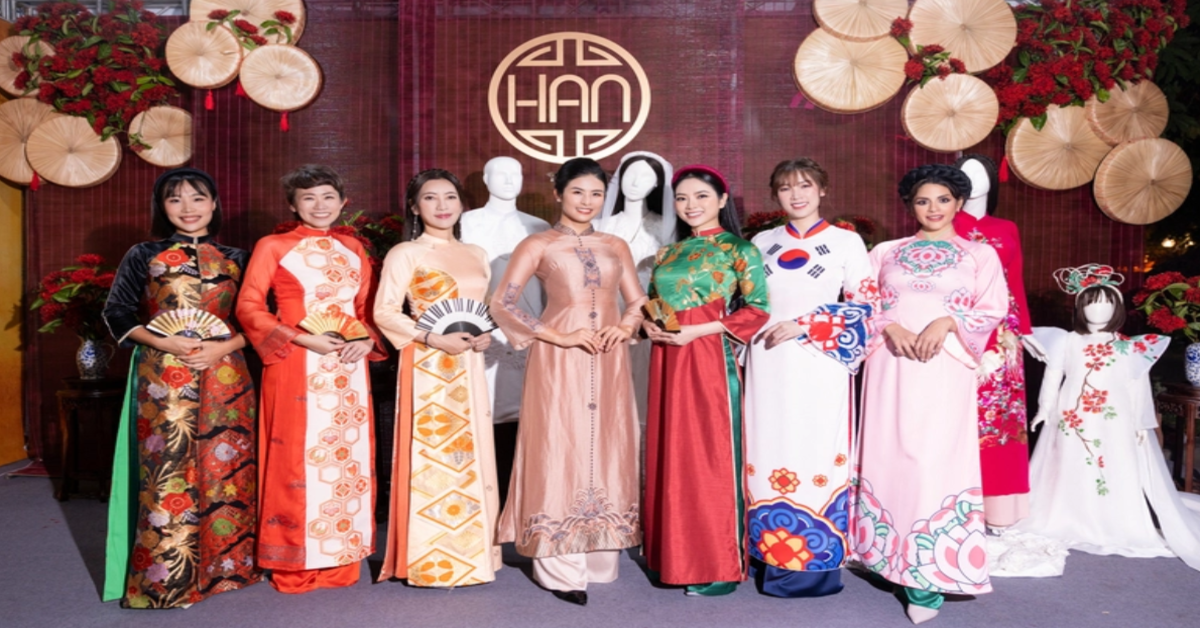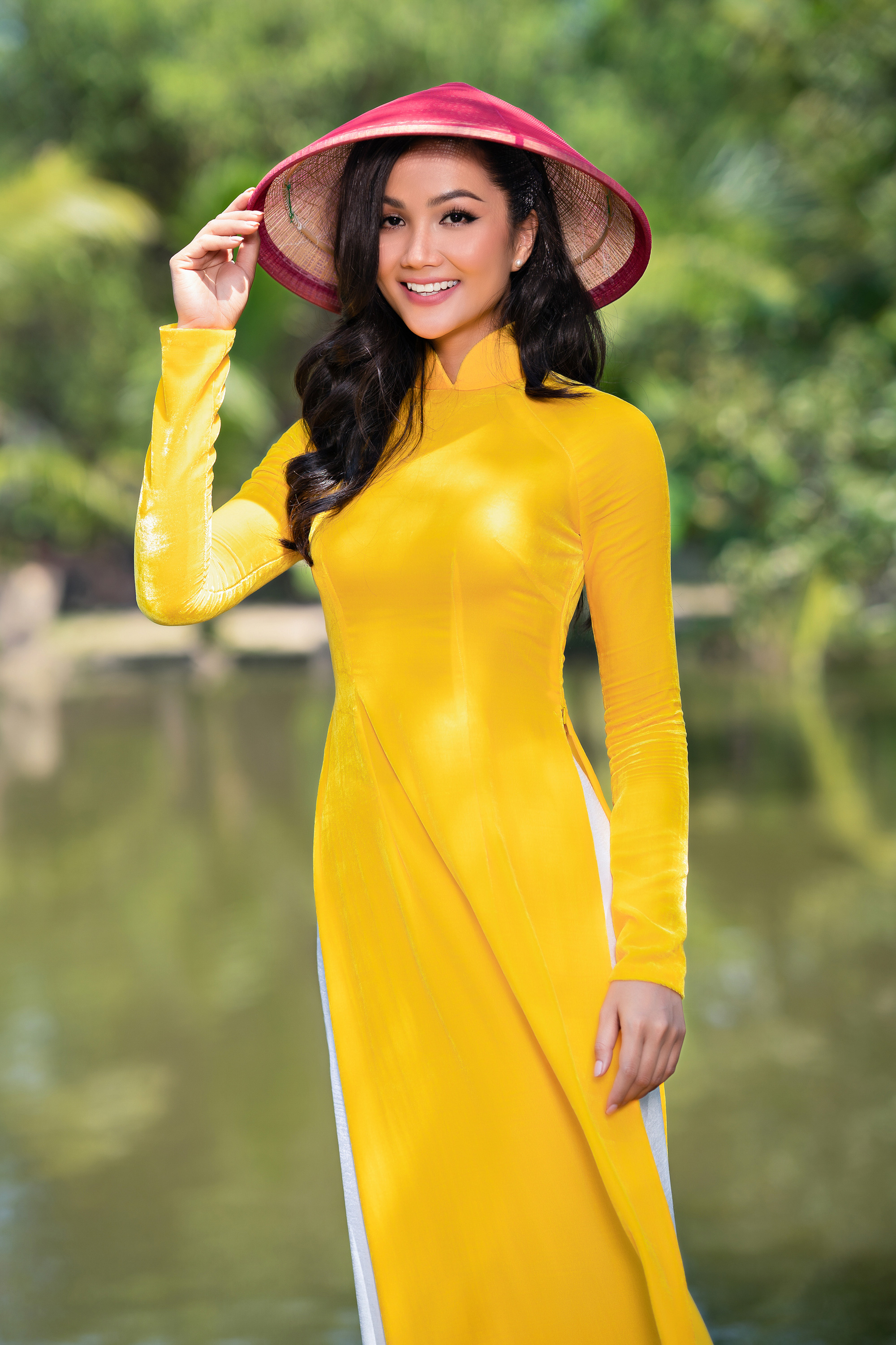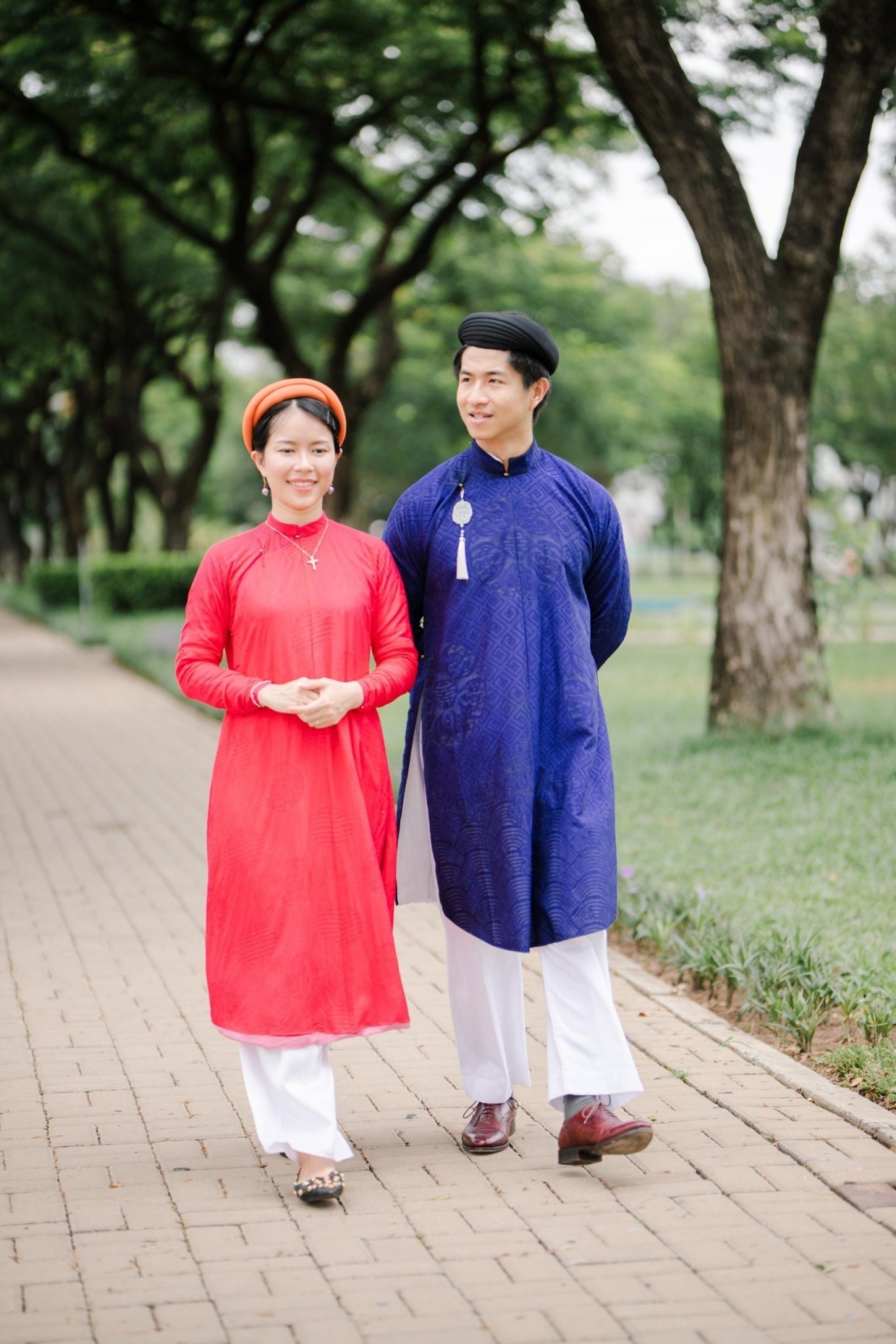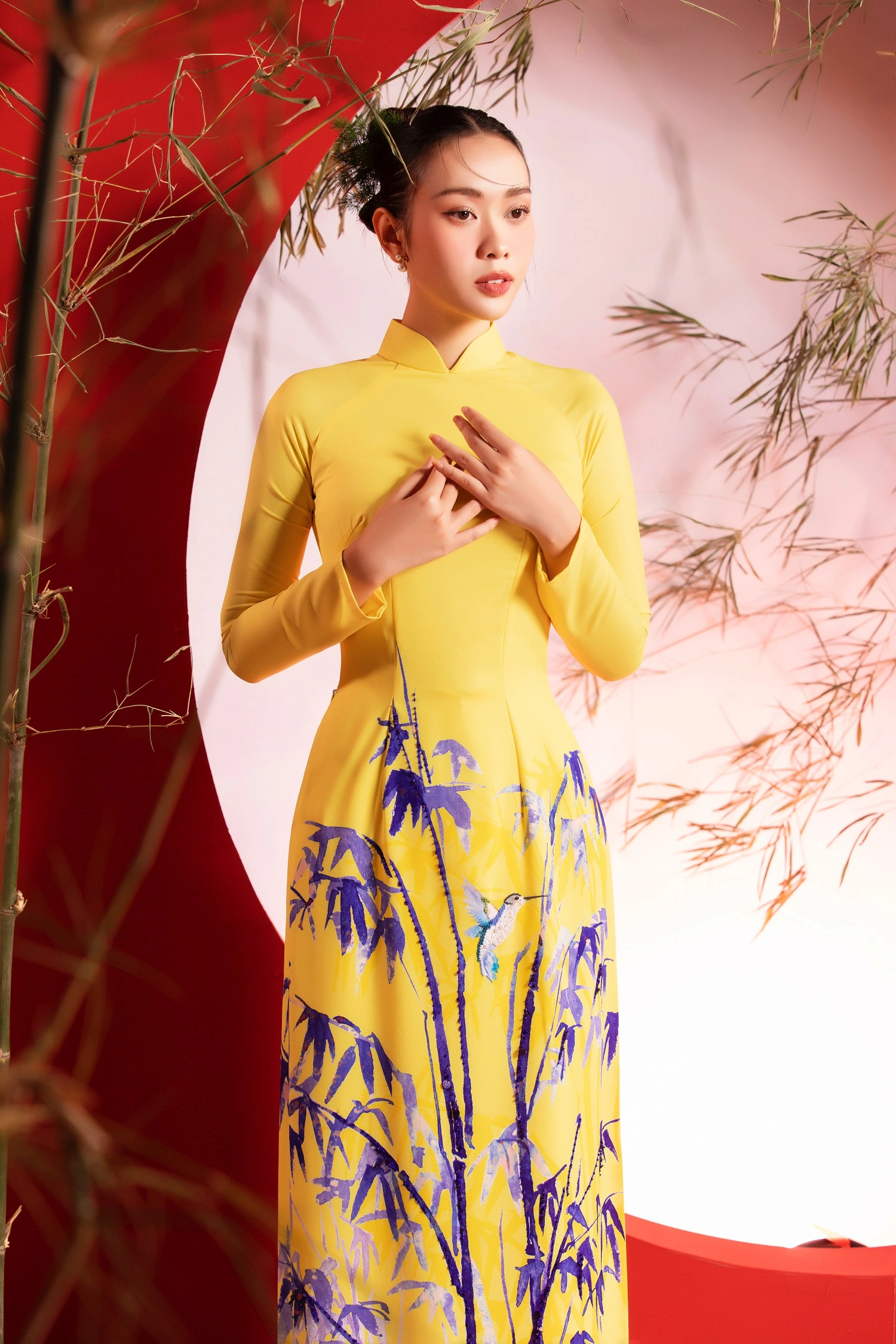
Ao dai – a national costume living with history of Vietnam
Flowing with elegance and steeped in tradition, the Ao Dai is more than just a garment; it’s a vibrant symbol that embodies the soul of Vietnam. Its history stretches back centuries, intricately woven into the fabric of the nation’s narrative. This introduction delves into the captivating story of the Ao Dai – Vietnamese’s national costume. We’ll explore its possible ancient roots, its transformation under different dynasties, and the French influence that shaped its modern form.

The historical story of Ao Dai
The Áo Dài boasts a rich history, evolving alongside Vietnam itself. Here’s a glimpse into its fascinating journey:
Possible Origins (Pre-18th Century):
- The exact origins of the Áo Dài are debated. Some theories suggest its inspiration came from garments worn by the Trung sisters, Vietnamese heroines who led a rebellion against Chinese rule as early as 38-42 AD.
- Another theory points towards the Áo Giao Linh, a long tunic worn by the Trinh Lords in northern Vietnam during the 16th and 17th centuries.
The Rise of the Áo Dài (18th Century):
- The more widely accepted story places the Áo Dài’s emergence in the 18th century under the Nguyễn Dynasty in southern Vietnam.
- King Nguyễn Phúc Khoát is credited with introducing a new style of clothing called the Áo ngũ thân (five-piece garment). This consisted of a long tunic worn over loose pants, with a resemblance to the Chinese Aoqun.
Transformation and Refinement (19th – Early 20th Century):
- The Áo ngũ thân evolved throughout the 19th and early 20th centuries.
- The five separate pieces were simplified into a two-part garment, with the top and lower sections sewn together.
- The front flap became longer, reaching the ankles, and the overall silhouette became more fitted.
French Influence and Modernization (1920s – 1940s):
- French colonization in the late 19th century impacted Vietnamese fashion, including the Áo Dài.
- Vietnamese artists like Nguyễn Cát Tường (Le Mur) in the 1920s and 1930s played a key role in modernizing the Áo Dài.
- They incorporated French design elements like a more defined waistline and a higher collar, creating a more streamlined and elegant look.
- This new style, embraced by urban women, became a symbol of national identity with a modern twist.
National Costume – Dress and Symbolism (Mid-20th Century – Present):
- After Vietnam gained independence in 1945, the Áo Dài became widely recognized as the national dress of Vietnam.
- It continued to evolve, with variations in sleeve styles, fabrics, and embellishments.
- The Áo Dài remained popular for formal occasions, special events, and as a symbol of Vietnamese culture.
- In recent decades, young Vietnamese designers have experimented with contemporary takes on the Áo Dài.
- Shorter lengths, various fabrics, and modern silhouettes have emerged, making the Áo Dài more adaptable to everyday wear while retaining its cultural significance.
The Áo Dài’s journey reflects Vietnam’s rich history and cultural influences. From its possible ancient roots to its modern adaptations, the Áo Dài continues to be a cherished symbol of Vietnamese heritage and national pride.
Appearance of Ao dai – a national costume of Vietnam

The Áo Dài (pronounced ow-zai) is a beautiful and symbolic garment that serves as Vietnam’s national costume. Here’s a breakdown of its appearance for both women and men:
Women’s Áo Dài national costume:
- Top:
- Made of flowing silk or other lightweight fabrics like cotton or linen.
- Features a high, stand-up collar that can vary in style.
- Buttons down the front, typically on the right side, though modern versions might have zippers or no closure.
- The bodice can be fitted to the waist or have a looser silhouette.
- Skirt:
- Long and flowing, reaching the ankles or sometimes even the floor.
- A deep slit runs up both sides of the skirt, allowing for ease of movement.
- May have a slight train in formal versions.
- Sash:
- A long piece of fabric, often made of silk and complementary to the Áo Dài’s color or pattern.
- Worn wrapped around the waist, cinching it and creating a flattering silhouette.
Men’s Áo Dài:

- Top:
- Similar to the women’s version but looser fitting overall.
- Reaches down to the knees or slightly below.
- Features a high collar and buttons down the front, similar to the women’s design.
- Pants:
- Worn with loose-fitting trousers made of silk or cotton, often in a matching or complementary color to the Áo Dài.
- The pants may have a slightly tapered leg or a straight cut.
- Sash:
- Less common for men’s Áo Dài, but sometimes a sash might be worn to accentuate the waist.
Uses and traditions of Ao Dai – a national costume of Vietnam
The Áo Dài holds a significant place in Vietnamese culture, serving not just as clothing but as a symbol of tradition, beauty, and national pride. Here’s a deeper dive into its use and traditions:
Special Occasions to wear National Costume:
- Formality: The Áo Dài is most commonly worn during formal events and celebrations. This includes weddings, both for brides and grooms (sometimes) and for guests attending the ceremony.
- National Holidays: During Tet (Lunar New Year), the Áo Dài is a popular choice for family gatherings and festivities.
- Official Events: Government officials, diplomats, and other dignitaries might wear the Áo Dài for official ceremonies or cultural functions.
Cultural Representation by National Costume:
- Flight attendants, hotel staff, and other service personnel might wear a variation of the Áo Dài as part of their uniform, showcasing Vietnamese culture to visitors.
- Students: In some schools, especially high schools, female students might have the Áo Dài as part of their uniform, particularly for important events or school ceremonies.
- Performances: Traditional dance performances and cultural shows often feature Áo Dài costumes, reflecting the elegance and grace of Vietnamese attire.
Evolution and Modernization:
- While traditionally associated with formal wear, the Áo Dài has evolved in recent times.
- Modern designs with shorter lengths, different sleeve styles, and a wider variety of fabrics are gaining popularity for everyday wear.
- Young Vietnamese designers are reinterpreting the Áo Dài, creating contemporary styles that blend tradition with modern aesthetics.
National Costume – Beyond Clothing:
- The Áo Dài is more than just a piece of clothing; it’s a symbol of Vietnamese heritage and national identity.
- The flowing lines are said to reflect the beauty of Vietnamese landscapes, while the intricate embroidery on some Áo Dài showcases traditional Vietnamese art forms.
- Wearing an Áo Dài is a way to connect with Vietnamese culture and express respect for tradition
The Ao Dai: Embracing Change While Honoring Tradition

The Vietnamese national dress, the Ao Dai, boasts a rich history, but its story isn’t over. Today, the Ao Dai is undergoing a fascinating transformation, adapting to modern sensibilities while holding onto its cultural significance. Here’s a look at how the Ao Dai is changing in the 21st century:
Modern Materials and Designs:
- Fabric Revolution: Traditionally made of silk, the Ao Dai is now crafted from a wider variety of materials. Breathable cotton, flowy chiffon, and even luxurious brocade offer wearers more options for comfort and style.
- Shorter Lengths: While the floor-length gown remains a classic choice for formal occasions, shorter Ao Dai reaching the knees or calves are gaining popularity for everyday wear or less formal settings.
- Sleeve Evolution: The traditional long sleeves are being joined by modern variations like short sleeves, cap sleeves, and even sleeveless versions, offering a cooler and more versatile option for warmer climates.
A Blend of Tradition and Innovation:
- Contemporary Cuts: Modern designers are experimenting with bolder silhouettes, like A-line cuts or asymmetrical designs, adding a touch of modern flair while staying true to the essence of the Ao Dai.
- Embracing Diversity: The traditional color palette is expanding to include a wider range of hues, from bold and playful colors to softer pastels. Additionally, modern embroidery patterns featuring florals, geometric shapes, or even abstract designs add a touch of individuality.
- Comfort Reigns Supreme: Modern Ao Dai designs prioritize comfort alongside style. Features like hidden zippers or adjustable waistlines ensure a better fit and greater ease of movement.
Beyond Special Occasions:
- Everyday Elegance: The rise of modernized Ao Dai allows them to be worn for a wider range of occasions. They can be dressed up for work or dressed down for a casual outing, showcasing Vietnamese heritage in everyday life.
- Street Style Inspiration: Fashion bloggers and social media influencers are incorporating the Ao Dai into their street style look, inspiring young Vietnamese women to embrace the national dress in a fresh and modern way.
- Global Recognition: International designers are featuring elements of the Ao Dai in their collections, bringing a touch of Vietnamese elegance to the global fashion scene.
The Future of Ao Dai:
The Ao Dai’s evolution reflects Vietnam’s dynamism. As the nation embraces the future, the Ao Dai will continue to adapt, finding new ways to express Vietnamese culture while remaining a relevant and cherished part of Vietnamese identity.
See also:
